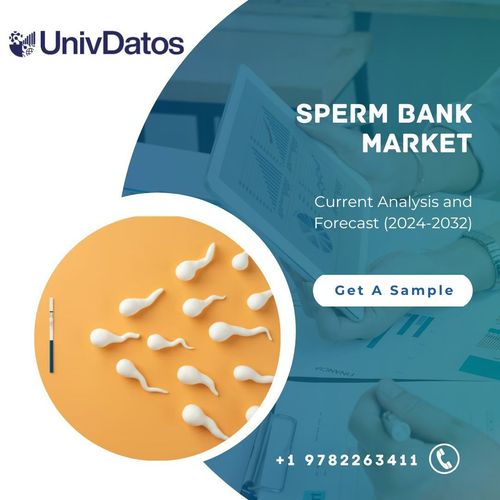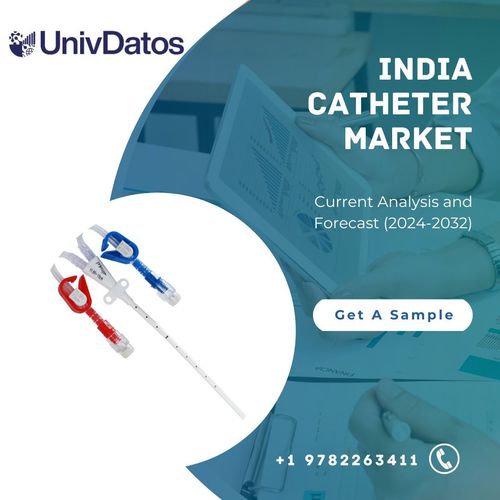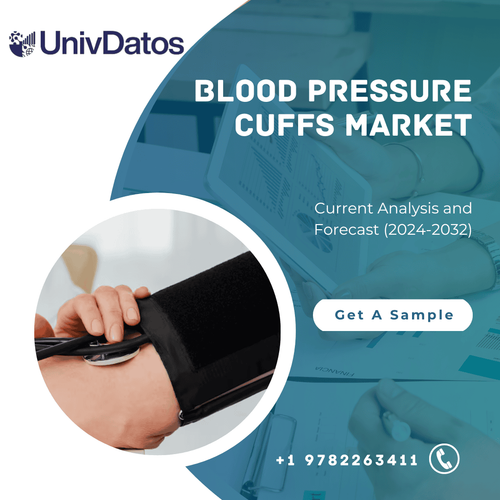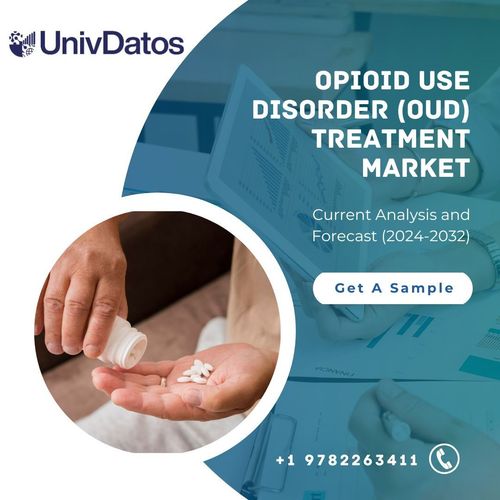Quinidine Sulfate Market: Current Analysis and Forecast (2023-2030)
Emphasis on Mode of Administration (Oral and Intravenous); Application (Malaria, Arrhythmias, and Others); and Region/Country
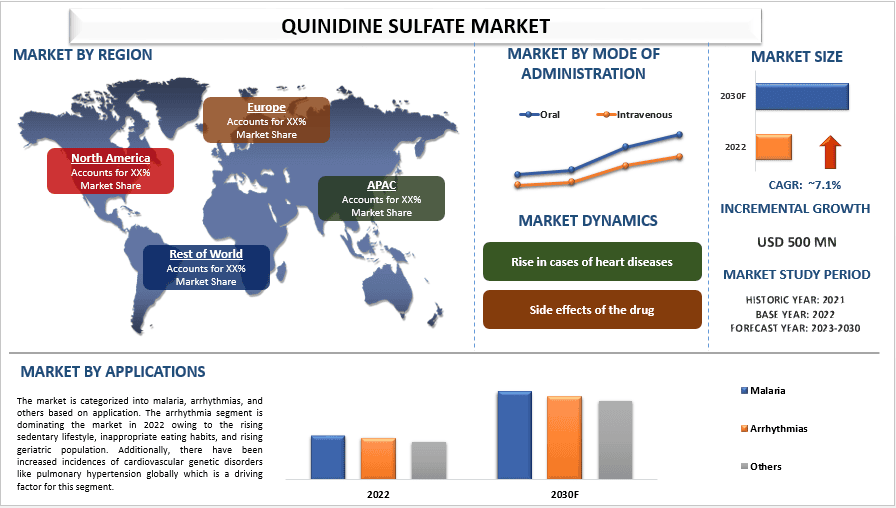
The Global Quinidine Sulfate Market is expected to reach USD 500 Million in 2030 by growing at a CAGR of 7.1%. Quinidine sulfate services mainly gained prominence due to the increased number of malaria and cardiovascular cases globally. For instance, in July 2023, the Centers for Disease Control and Prevention (CDC) reported only about 1 in 4 adults with hypertension have their hypertension under control. In addition to this, investments in cardiovascular departments as well as government awareness programs regarding controlling the spread of malaria and the occurrence of heart diseases have increased significantly in recent years, which are the key factors that are creating opportunities for the market. Many other factors were identified that helped in propelling the market in the forecast period such as the surge in awareness programs regarding communicable diseases like malaria and cardiovascular diseases, the increasing smoking population, rising alcoholism culture leading to cardiovascular diseases are also driving the growth of the market. For instance, in November 2021, the Support Network-Ghana (SASNET-GHANA) celebrated World Heart Day on 29, September 2021 by raising population awareness of cardiovascular diseases (CVD) through the usage of traditional and social media. Also, the Center for Disease Control and Prevention (CDC), provides information related to malaria through its division of parasitic diseases and malaria diagnostic website, which is available 24 hours a day to support and provide early diagnosis and treatment.
Bennet Pharmaceuticals Limited; Buchler GmbH; Cipla Inc.; Ipca Laboratories Ltd.; Larklab; Merck KGaA; PRISM INDUSTRIES PRIVATE LIMITED; Teva Pharmaceutical Industries Ltd.; VIVAN Life Sciences; Biophore. are some of the key players in the market. Several M&As along with partnerships have been undertaken by these players to facilitate customers with hi-tech and innovative products/technologies.
Insights Presented in the Report
“Amongst mode of administration, intravenous category to witness higher CAGR during the forecast period.”
Based on the mode of administration, the market is bifurcated into oral and intravenous segments. The intravenous segment is expected to grow with a high CAGR during the forecast period as a faster mode of action and effectiveness. For instance, according to the National Library of Medicine’s article in February 2023, the intravenous mode of drug administration provides the most complete drug availability with negligible delay. Also, this mode is comfortable for patients who face difficulty in ingesting medicines orally. Thus, amongst modes of administration, the intravenous category is expected to witness higher CAGR during the forecast period.
“Amongst application, arrhythmias held a significant share in the market in 2022”
The market is categorized into malaria, arrhythmias, and others based on application. The arrhythmia segment is dominating the market in 2022 owing to the rising sedentary lifestyle, inappropriate eating habits, and rising geriatric population. Additionally, there have been increased incidences of cardiovascular genetic disorders like pulmonary hypertension globally which is a driving factor for this segment. For instance, according to a report published in 2022, by the American Heart Association, a US-based organization, the age-adjusted prevalence rate of cardiovascular diseases was 7354.1 per 100,000 people in 2020. Owing to the above reasons, the arrhythmias segment held a significant share of the market in the year 2022.
“Amongst regions, North America held higher CAGR during the forecast period”
For a better understanding of the market adoption of quinidine sulfate, the market is analyzed based on its worldwide presence in countries such as North America (U.S., Canada, and Rest of North America), Europe (Germany, U.K., France, Spain, Italy, Rest of Europe), Asia-Pacific (China, Japan, India, Rest of Asia-Pacific), Rest of World. APAC is expected to grow with a high CAGR during the forecast period. Several factors such as a surge in the geriatric population in the region, development of a wide range of therapeutics with quinidine sulfate, and enhanced accessibility of pharmaceutical products are driving the market’s growth during the forecast period. Further, the increase in incidences of malaria in several parts of the region, the presence of key generic pharmaceutical companies in the region, and the surge in government initiatives and special communities are also positively impacting the market’s growth. There have been significant improvisations and enhancements in quinidine sulfate in the region. For example, as per the news of The Times of India in May 2023, out of 247 million malaria cases globally in 2021, the APAC region contributed to 1.79 million cases. Hence, North America is supposed to witness a higher CAGR during the forecast period.

Reasons to buy this report:
- The study includes market sizing and forecasting analysis validated by authenticated key industry experts.
- The report presents a quick review of overall industry performance at one glance.
- The report covers an in-depth analysis of prominent industry peers with a primary focus on key business financials, product portfolio, expansion strategies, and recent developments.
- Detailed examination of drivers, restraints, key trends, and opportunities prevailing in the industry.
- The study comprehensively covers the market across different segments.
- Deep dive regional level analysis of the industry.
Customization Options:
The global quinidine sulfate market can further be customized as per the requirement or any other market segment. Besides this, UMI understands that you may have your own business needs, hence feel free to connect with us to get a report that completely suits your requirements.
Table of Contents
Research Methodology for the Quinidine Sulfate Market Analysis (2023-2030)
Analyzing the historical market, estimating the current market, and forecasting the future market of the global quinidine sulfate market were the three major steps undertaken to create and analyze the adoption of quinidine sulfate in major regions globally. Exhaustive secondary research was conducted to collect the historical market numbers and estimate the current market size. Secondly, to validate these insights, numerous findings and assumptions were taken into consideration. Moreover, exhaustive primary interviews were also conducted, with industry experts across the value chain of the global quinidine sulfate market. Post assumption and validation of market numbers through primary interviews, we employed a top-down/bottom-up approach to forecasting the complete market size. Thereafter, market breakdown and data triangulation methods were adopted to estimate and analyze the market size of segments and sub-segments of the industry pertains to. Detailed methodology is explained below:
Analysis of Historical Market Size
Step 1: In-Depth Study of Secondary Sources:
Detail secondary study was conducted to obtain the historical market size of the quinidine sulfate market through company internal sources such as annual reports & financial statements, performance presentations, press releases, etc., and external sources including journals, news & articles, government publications, competitor publications, sector reports, third-party database, and other credible publications.
Step 2: Market Segmentation:
After obtaining the historical market size of the quinidine sulfate market, we conducted a detailed secondary analysis to gather historical market insights and share for different segments & sub-segments for major regions. Major segments are included in the report as mode of administration, application, and regions. Further country-level analyses were conducted to evaluate the overall adoption of testing models in that region.
Step 3: Factor Analysis:
After acquiring the historical market size of different segments and sub-segments, we conducted a detailed factor analysis to estimate the current market size of the quinidine sulfate market. Further, we conducted factor analysis using dependent and independent variables such as mode of administration, application, and regions of quinidine sulfate. A thorough analysis was conducted for demand and supply-side scenarios considering top partnerships, mergers and acquisitions, business expansion, and product launches in the quinidine sulfate market sector across the globe.
Current Market Size Estimate & Forecast
Current Market Sizing: Based on actionable insights from the above 3 steps, we arrived at the current market size, key players in the global quinidine sulfate market, and market shares of the segments. All the required percentage shares split, and market breakdowns were determined using the above-mentioned secondary approach and were verified through primary interviews.
Estimation & Forecasting: For market estimation and forecast, weights were assigned to different factors including drivers & trends, restraints, and opportunities available for the stakeholders. After analyzing these factors, relevant forecasting techniques i.e., the top-down/bottom-up approach were applied to arrive at the market forecast for 2030 00for different segments and sub-segments across the major markets globally. The research methodology adopted to estimate the market size encompasses:
- The industry’s market size, in terms of revenue (USD) and the adoption rate of the quinidine sulfate market across the major markets domestically
- All percentage shares, splits, and breakdowns of market segments and sub-segments
- Key players in the global quinidine sulfate market in terms of products offered. Also, the growth strategies adopted by these players to compete in the fast-growing market
Market Size and Share Validation
Primary Research: In-depth interviews were conducted with the Key Opinion Leaders (KOLs) including Top Level Executives (CXO/VPs, Sales Head, Marketing Head, Operational Head, Regional Head, Country Head, etc.) across major regions. Primary research findings were then summarized, and statistical analysis was performed to prove the stated hypothesis. Inputs from primary research were consolidated with secondary findings, hence turning information into actionable insights.
Split of Primary Participants in Different Regions
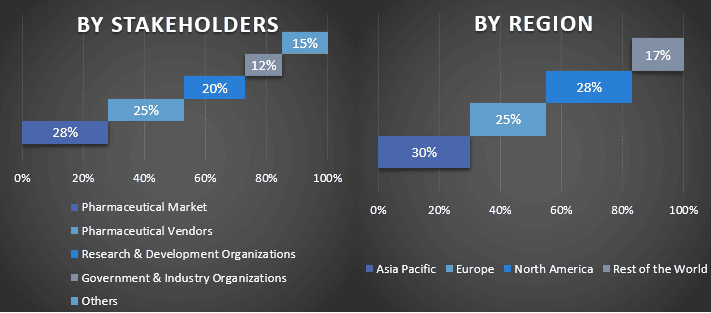
Market Engineering
The data triangulation technique was employed to complete the overall market estimation and to arrive at precise statistical numbers for each segment and sub-segment of the global quinidine sulfate market. Data was split into several segments & sub-segments post studying various parameters and trends in the areas of mode of administration, application, and regions in the global quinidine sulfate market.
The main objective of the Global Quinidine Sulfate Market Study
The current & future market trends of the global quinidine sulfate market were pinpointed in the study. Investors can gain strategic insights to base their discretion for investments on the qualitative and quantitative analysis performed in the study. Current and future market trends determined the overall attractiveness of the market at a regional level, providing a platform for the industrial participant to exploit the untapped market to benefit from a first-mover advantage. Other quantitative goals of the studies include:
- Analyze the current and forecast market size of the quinidine sulfate market in terms of value (USD). Also, analyze the current and forecast market size of different segments and sub-segments
- Segments in the study include areas of mode of administration, application, and regions
- Define and analyze the regulatory framework for the quinidine sulfate industry.
- Analyze the value chain involved with the presence of various intermediaries, along with analyzing customer and competitor behaviors of the industry.
- Analyze the current and forecast market size of the quinidine sulfate market for the major region.
- Major countries of regions studied in the report include Asia Pacific, Europe, North America, and the Rest of the World.
- Company profiles of the quinidine sulfate market and the growth strategies adopted by the market players to sustain in the fast-growing market
- Deep dive regional level analysis of the industry
Frequently Asked Questions FAQs
Q1: What is the current market size and growth potential of the quinidine sulfate market?
Q2: What are the driving factors for the growth of the quinidine sulfate market?
Q3: Which segment has the largest share of the quinidine sulfate market by mode of administration?
Q4: What are the emerging technologies and trends in the quinidine sulfate market?
Q5: Which region will dominate the quinidine sulfate market?
Q6: Who are the key players operating in the quinidine sulfate market?
Related Reports
Customers who bought this item also bought

